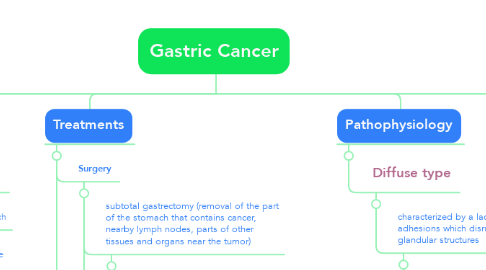
1. Types
1.1. Intestinal (well-differentiated, more common, 70%)
1.2. Diffuse (undifferentiated, less frequent, 30%, occurs at younger age, worse prognosis)
2. pernicious anemia
2.1. intestinal metaplasia (a condition in which the normal stomach lining is replaced with cells that line the intestines)
2.1.1. Familial adenomatous polyposis (FAP) or gastric polyps, benign gastric ulcer, hypertrophic gastropathy
2.1.1.1. Epstein-Barr virus infection
3. Risk/Causative Factors
3.1. Associated medical conditions
3.1.1. Helicobacter pylori infection of the stomach
3.1.1.1. chronic gastritis (inflammation of the stomach)
3.2. Eating a diet high in salted, smoked foods and low in fruits and vegetables
3.3. Eating foods that have not been prepared or stored properly
3.4. Being older or male
3.5. Smoking cigarettes
3.6. Having a mother, father, sister or brother who has had stomach cancer
3.6.1. most gastric cancers are sporadic but 5% to 10% of cases have a family history of gastric cancer.
3.6.1.1. Hereditary diffuse gastric cancer (HDGC), gastric adenocarcinoma and proximal polyposis of the stomach (GAPPS), and familial intestinal gastric cancer (FIGC) are three major syndromes accounting up to 3% to 5% of hereditary familial gastric cancer
3.7. Radiation exposure, occupational exposure to rubber manufacturing, tin mining, metal processing, and coal
4. Treatments
4.1. Surgery
4.1.1. subtotal gastrectomy (removal of the part of the stomach that contains cancer, nearby lymph nodes, parts of other tissues and organs near the tumor)
4.1.1.1. total gastrectomy (removal of the entire stomach, nearby lymph nodes, and parts of the esophagus, small intestine, and other tissues near the tumor)
4.1.2. Procedures if tumor is blocking the stomach but the cancer cannot be completely removed by surgery:
4.1.2.1. endoluminal stent placement
4.1.2.1.1. endoluminal laser therapy
4.2. Chemotherapy (uses drugs to stop the growth of cancer cells by killing them or stop them from dividing)
4.3. Radiation therapy (uses high-energy x-rays)
4.3.1. external radiation therapy
4.3.1.1. internal radiation therapy (uses radioactive substance sealed in needles, wires or catheters that are placed directly into or near the cancer
4.4. Chemoradiation therapy
4.5. Targeted therapy (uses drugs or substances to identify and attack specific cancer cells without harming normal cells. Monoclonal antibody therapy is used in gastric cancer
5. Pathophysiology
5.1. Diffuse type
5.1.1. characterized by a lack of intercellular adhesions which disrupt the formation of glandular structures
5.1.1.1. the inherited form has absent intercellular adhesions caused by a germline mutation (HDGC) in the cell adhesion protein E-cadherin (CDH1)
5.1.1.1.1. HDGC (hereditary diffuse gastric cancer) is inherited as an autosomal dominant trait with high penetrance, highly invasive, late presentation (average age 38) and poor prognosis
6. Tests and Procedures
6.1. Physical exam and history
6.1.1. Intestinal type
6.1.1.1. so called due to its morphologic similarity to adenocarcinomas arising in the intestinal tract
6.1.1.1.1. can be attributed as a progression from chronic gastritis caused by H. pylori, pernicious anemia, or high-salt diets leading to a loss of parietal cells, reducing acid production causing chronic atrophic gastritis
6.2. Blood chemistry studies
6.3. Complete blood count
6.4. Upper endoscopy
6.5. Barium swallow/ upper GI series
6.6. CT scan
6.7. Biopsy
7. Common Findings
7.1. Early Stages
7.1.1. indigestion and stomach discomfort
7.1.1.1. a bloated feeling after eating
7.1.1.1.1. mild nausea
7.2. Advanced Stages
7.2.1. blood in stool
7.2.1.1. vomiting
7.2.1.1.1. weight loss for no known reason

